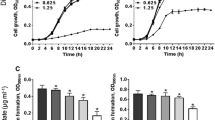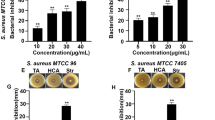Abstract
Methicillin resistant Staphylococcus aureus is considered multidrug resistant bacterium due to developing biofilm formation associated with antimicrobial resistance mechanisms. Therefore, inhibition of biofilm formation is an alternative therapeutic action to control MRSA infections. The present study revealed the non-antibacterial biofilm inhibitory potential of hesperidin against ATCC strain and clinical isolates of S. aureus. Hesperidin is a flavanone glycoside commonly found in citrus fruit. Hesperidin has been shown to exhibits numerous pharmacological activities. The present study aimed to evaluate the antibiofilm and antivirulence potential of hesperidin against MRSA. Results showed that hesperidin treatment significantly impedes lipase, hemolysin, autolysin, autoaggregation and staphyloxanthin production. Reductions of staphyloxanthin production possibly increase the MRSA susceptibility rate to H2O2 oxidative stress condition. In gene expression study revealed that hesperidin treatment downregulated the biofilm-associated gene (sarA), polysaccharide intracellular adhesion gene (icaA and icaD), autolysin (altA), fibronectin-binding protein (fnbA and fnbB) and staphyloxanthin production (crtM). Molecular docking analysis predicted the ability of hesperidin to interact with SarA and CrtM proteins involved in biofilm formation and staphyloxanthin production in MRSA.








Similar content being viewed by others
References
Atanasov AG, Zotchev SB, Dirsch VM, Supuran CT (2021) Natural products in drug discovery: advances and opportunities. Nat Rev Drug Discov 20:200–216
Balamurugan P, Hema M, Kaur G, Sridharan V, Prabu PC, Sumana MN, Princy SA (2015) Development of a biofilm inhibitor molecule against multidrug resistant Staphylococcus aureus associated with gestational urinary tract infections. Front Microbiol 6:832
Chemmugil P, Lakshmi PTV, Annamalai A (2019) Exploring morin as an anti-quorum sensing agent (anti-QSA) against resistant strains of Staphylococcus aureus. Microb Pathog 127:304–315
Clauditz A, Resch A, Wieland KP, Peschel A, Götz F (2006) Staphyloxanthin plays a role in the fitness of Staphylococcus aureus and its ability to cope with oxidative stress. Infect Immun 74:4950–4953
Corciova A, Ciobanu C, Poiata A, Mircea C, Nicolescu A, Drobota M, Varganici CD, Pinteala T, Marangoci N (2015) Antibacterial and antioxidant properties of hesperidin: β-cyclodextrin complexes obtained by different techniques. J Incl Phenom Macrocycl Chem 81:71–84
Cue DR, Lei MG, Lee C (2012) Genetic regulation of the intercellular adhesion locus in staphylococci. Front Cell Infect Microbiol 2:38
Cue D, Junecko JM, Lei MG, Blevins JS, Smeltzer MS, Lee CY (2015) SaeRS-dependent inhibition of biofilm formation in Staphylococcus aureus Newman. PLoS ONE 10:e0123027
Høiby N, Bjarnsholt T, Givskov M, Molin S, Ciofu O (2010) Antibiotic resistance of bacterial biofilms. Int J Antimicrob Agents 35:322–332
Hollands A, Aziz RK, Kansal R, Kotb M, Nizet V, Walker MJ (2008) A naturally occurring mutation in ropB suppresses SpeB expression and reduces M1T1 group A streptococcal systemic virulence. PLoS ONE 3:e4102
Houston P, Rowe SE, Pozzi C, Waters EM, O’Gara JP (2011) Essential role for the major autolysin in the fibronectin-binding protein-mediated Staphylococcus aureus biofilm phenotype. Infect Immun 79:1153–1165
Iacovache I, van der Goot FG, Pernot L (2008) Pore formation: an ancient yet complex form of attack. Biochem Biophys Acta Biomembr 1778:1611–1623
Jenul C, Horswill AR (2019) Regulation of Staphylococcus aureus virulence. Microbiol Spectr 7:7–2
Kahlon AK, Roy S, Sharma A (2010) Molecular docking studies to map the binding site of squalene synthase inhibitors on dehydrosqualene synthase of Staphylococcus aureus. J Biomol Struct Dyn 28:201–210
Karuppiah V, Thirunanasambandham R (2020) Quebrachitol from Rhizophora mucronata inhibits biofilm formation and virulence production in Staphylococcus epidermidis by impairment of initial attachment and intercellular adhesion. Archiv Microbiol 202:1327–1340
Karuppiah V, Thirunanasambandham R, Thangaraj G (2021) Anti-quorum sensing and antibiofilm potential of 1, 8-cineole derived from Musa paradisiaca against Pseudomonas aeruginosa strain PAO1. World J Microbiol Biotechnol 37:1–12
Kot B, Sytykiewicz H, Sprawka I, Witeska M (2019) Effect of trans-cinnamaldehyde on methicillin-resistant Staphylococcus aureus biofilm formation: metabolic activity assessment and analysis of the biofilm-associated genes expression. Int J Mol Sci 21:102
Lee AS, de Lencastre H, Garau J, Kluytmans J, Malhotra-Kumar S, Peschel A, Harbarth S (2018) Methicillin-resistant Staphylococcus aureus. Nat Rev Dis Primers 4:1–23
Leejae S, Hasap L, Voravuthikunchai SP (2013) Inhibition of staphyloxanthin biosynthesis in Staphylococcus aureus by rhodomyrtone, a novel antibiotic candidate. J Med Microbiol 62:421–428
Li L, Cheung A, Bayer AS, Chen L, Abdelhady W, Kreiswirth BN, Yeaman MR, Xiong YQ (2016) The global regulon sarA regulates β-lactam antibiotic resistance in methicillin-resistant Staphylococcus aureus in vitro and in endovascular infections. J Infect Dis 214:1421–1429
Li X, Huang T, Xu K, Li C, Li Y (2019) Molecular characteristics and virulence gene profiles of Staphylococcus aureus isolates in Hainan, China. BMC Infect Dis 19:1–12
Liu CI, Jeng WY, Chang WJ, Ko TP, Wang AHJ (2012) Binding modes of zaragozic acid A to human squalene synthase and staphylococcal dehydrosqualene synthase. J Biol Chem 287:18750–18757
Liu Q, Yeo WS, Bae T (2016) The SaeRS two-component system of Staphylococcus aureus. Genes 7:81
Mani N, Tobin P, Jayaswal RK (1993) Isolation and characterization of autolysis-defective mutants of Staphylococcus aureus created by Tn917-lacZ mutagenesis. J Bacteriol 175:1493–1499
Mishra R, Panda AK, De Mandal S, Shakeel M, Bisht SS, Khan J (2020) Natural anti-biofilm agents: strategies to control biofilm-forming pathogens. Front Microbiol 11:2640
Otto M (2013) Staphylococcal infections: mechanisms of biofilm maturation and detachment as critical determinants of pathogenicity. Annu Rev Med 64:175–188
Pelz A, Wieland KP, Putzbach K, Hentschel P, Albert K, Götz F (2005) Structure and biosynthesis of staphyloxanthin from Staphylococcus aureus. J Biol Chem 280:32493–32498
Rabin N, Zheng Y, Opoku-Temeng C, Du Y, Bonsu E, Sintim HO (2015) Agents that inhibit bacterial biofilm formation. Future Med Chem 7:647–671
Rasmussen TB, Givskov M (2006) Quorum sensing inhibitors: a bargain of effects. Microbiology 152:895–904
Roy R, Tiwari M, Donelli G, Tiwari V (2018) Strategies for combating bacterial biofilms: a focus on anti-biofilm agents and their mechanisms of action. Virulence 9:522–554
Samie A, Sedaghat R, Baluchnejadmojarad T, Roghani M (2018) Hesperetin, a citrus flavonoid, attenuates testicular damage in diabetic rats via inhibition of oxidative stress, inflammation, and apoptosis. Life Sci 210:132–139
Selvaraj A, Jayasree T, Valliammai A, Pandian SK (2019) Myrtenol attenuates MRSA biofilm and virulence by suppressing sarA expression dynamism. Front Microbiol 10:2027
Sethupathy S, Vigneshwari L, Valliammai A, Balamurugan K, Pandian SK (2017) L-Ascorbyl 2, 6-dipalmitate inhibits biofilm formation and virulence in methicillin-resistant Staphylococcus aureus and prevents triacylglyceride accumulation in Caenorhabditis elegans. RSC Adv 7:23392–23406
Sorroche FG, Spesia MB, Zorreguieta A, Giordano W (2012) A positive correlation between bacterial autoaggregation and biofilm formation in native Sinorhizobium meliloti isolates from Argentina. Appl Environ Microbiol 78:4092–4101
Stewart PS, Costerton JW (2001) Antibiotic resistance of bacteria in biofilms. The Lancet 358:135–138
Subramenium GA, Vijayakumar K, Pandian SK (2015) Limonene inhibits streptococcal biofilm formation by targeting surface-associated virulence factors. J Med Microbiol 64:879–890
Tan L, Li SR, Jiang B, Hu XM, Li S (2018) Therapeutic targeting of the Staphylococcus aureus accessory gene regulator (agr) system. Front Microbiol 9:55
Thammavongsa V, Kim HK, Missiakas D, Schneewind O (2015) Staphylococcal manipulation of host immune responses. Nat Rev Microbiol 13:529–543
Troeman DPR, Van Hout D, Kluytmans JAJW (2019) Antimicrobial approaches in the prevention of Staphylococcus aureus infections: a review. J Antimicrob Chemother 74:281–294
Valliammai A, Sethupathy S, Priya A, Selvaraj A, Bhaskar JP, Krishnan V, Pandian SK (2019) 5-Dodecanolide interferes with biofilm formation and reduces the virulence of methicillin-resistant Staphylococcus aureus (MRSA) through up regulation of agr system. Sci Rep 9:1–16
Vijayakumar K, Ramanathan T (2018) Antiquorum sensing and biofilm potential of 5-Hydroxymethylfurfural against gram positive pathogens. Microb Pathog 125:48–50
Vijayakumar K, Ramanathan T (2020) Musa acuminata and its bioactive metabolite 5-Hydroxymethylfurfural mitigates quorum sensing (las and rhl) mediated biofilm and virulence production of nosocomial pathogen Pseudomonas aeruginosa in vitro. J Ethnopharmacol 246:112242
Vijayakumar K, Thirunanasambandham R (2021) 5-Hydroxymethylfurfural inhibits Acinetobacter baumannii biofilms: an in vitro study. Archiv Microbiol 203:673–682
Vijayakumar K, Bharathidasan V, Manigandan V, Jeyapragash D (2020) Quebrachitol inhibits biofilm formation and virulence production against methicillin-resistant Staphylococcus aureus. Microb Pathog 149:104286
Vijayakumar K, Manigandan V, Jeyapragash D, Bharathidasan V, Anandharaj B, Sathya M (2020) Eucalyptol inhibits biofilm formation of Streptococcus pyogenes and its mediated virulence factors. J Med Microbiol 69:1308–1318
WHO (2015) Antibiotic resistance: Multi-country public awareness survey I. World Health Organization. ISBN 978 92 4 150981 7 Subject headings are available from WHO institutional repository. http://apps.who.int/iris/bitstream/10665/194460/1/9789241509817_eng.pdf?ua=1. Accessed June 2017
WHO. Media Centre (2017) News Release. WHO publishes list of bacteria for which new antibiotics are urgently needed. 2017. http://www.who.int/mediacentre/news/releases/2017/bacteria-antibiotics-needed/en/. Accessed March 2017
Yamashita K, Kawai Y, Tanaka Y, Hirano N, Kaneko J, Tomita N, Ohta M, Kamio Y, Yao M, Tanaka I (2011) Crystal structure of the octameric pore of staphylococcal γ-hemolysin reveals the β-barrel pore formation mechanism by two components. Proc Natl Acad Sci USA 108:17314–17319
Acknowledgements
The authors gratefully thank Dr. G. Ashwinkumar Subramenium for support in discussing and fulfilling the work. This research did not receive any specific grant from funding agencies in the public, commercial, or not-for-profit sectors.
Funding
Not applicable.
Author information
Authors and Affiliations
Contributions
KV—Conceptualization of whole work, performed the experiments, data analysis and co-wrote the manuscript. SM, MAV—Performed the experiments, data analyzed, docking analysis and co-wrote the manuscript.
Corresponding author
Ethics declarations
Conflict of interest
All the authors declare that they have no conflict of interest.
Ethical approval
This study does not contain any experiments with human participants or animals performed by any of the authors.
Additional information
Publisher’s Note
Springer Nature remains neutral with regard to jurisdictional claims in published maps and institutional affiliations.
Rights and permissions
About this article
Cite this article
Vijayakumar, K., Muhilvannan, S. & Arun Vignesh, M. Hesperidin inhibits biofilm formation, virulence and staphyloxanthin synthesis in methicillin resistant Staphylococcus aureus by targeting SarA and CrtM: an in vitro and in silico approach. World J Microbiol Biotechnol 38, 44 (2022). https://doi.org/10.1007/s11274-022-03232-5
Received:
Accepted:
Published:
DOI: https://doi.org/10.1007/s11274-022-03232-5




